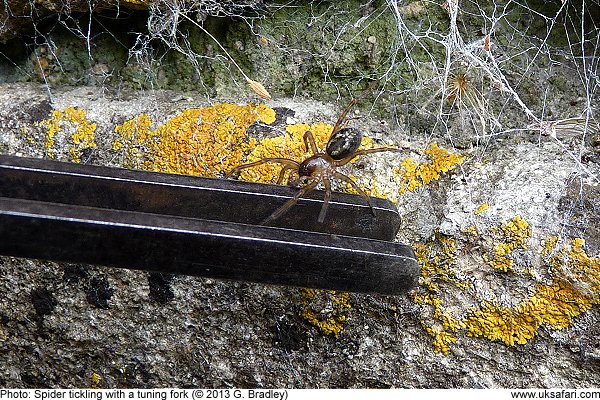 Spider Tickling!
Spider Tickling!
News > Spider Tickling! >

If you hunt around crumbly old walls you can sometimes spot small gaps and holes with strands of spider silk radiating out from them. Occasionally you'll see the legs of a spider just resting near the entrance to the hole. You know there's a spider at home, but how do you find out what type?
The answer is to tickle it out. Or more precisely to pretend to be the spiders lunch. Those strands of silk around the hole act like trip wires, so when a fly or some other insect touches one of them it causes a vibration along the strand. The spider at the other end of the strand picks up the vibration through its feet and comes rushing out to catch the insect.
You can simulate the movements of an insect tripping the wires by gently tickling them with a long blade of grass. If you have a vibrate function on your mobile phone, hold that next to the blade of grass as you stroke the other end across the silk. To a spider this will feel like the vibrating wings of a fly. Be careful of some of the larger tube web spiders. They can give a nasty bite, and they come running out of their holes very quickly with fangs flashing, so keep your fingers safely out of the way.
If you can get your hands on one, a metal tuning fork works even better. You can buy one quite cheaply on Ebay or from musical instrument stores. In the video below you can see a tuning fork being used to coax a Lace Web Spider out of its hidey hole.
More info at: UK Safari Spider Section

 Popular Pages
Popular Pages
Amphibians, Bats, Badgers, Beetles, Birds, Birds of Prey, Bumble Bees, Butterflies, Caterpillars, Creepy-Crawlies, Deadly Spiders, Dolphins, Dragonflies, E-Postcards, False Widow Spiders, Free Newsletter, Frogs, Fungi, Garden Spiders, Glow-Worms, Grey Squirrels, Hedgehogs, House Spiders, Ladybirds, Mammals, Marine Mammals, Moths, Owls, Reptiles, Spiders, Toads, Trees, Wildlife Hospitals
© Copyright 2018 G. Bradley - UK Safari | About Us | Links | Contributors



 Related Pages
Related Pages
